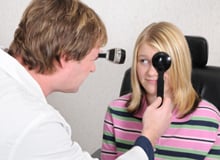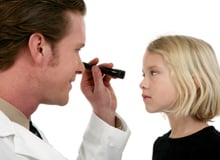Good vision develops early in life. A newborn’s vision develops rapidly during the first year. Therefore, early detection of childhood eye diseases and problems is critical so that the risk of permanent visual impairment is minimized.
Eye Exams
 Vision develops fully in children with little or no special attention. Although eye problems are rare, the majority can be treated if detected at an early age. Children’s eye exams at proper age intervals are the key to maintaining your child’s healthy vision. The earlier the visual problems are detected, the better the outcome. Virginia Eye Institute physicians partner with pediatricians, family physicians, and school nurses to ensure that when eye problems are detected WE pediatric specialists are able to further evaluate and treat the condition
Vision develops fully in children with little or no special attention. Although eye problems are rare, the majority can be treated if detected at an early age. Children’s eye exams at proper age intervals are the key to maintaining your child’s healthy vision. The earlier the visual problems are detected, the better the outcome. Virginia Eye Institute physicians partner with pediatricians, family physicians, and school nurses to ensure that when eye problems are detected WE pediatric specialists are able to further evaluate and treat the condition
Eye Screen for Children
 Why is regular vision screening so important, especially for children? Good vision is key to a child’s physical development, success in school and overall well-being. The vision system is not fully formed in babies and young children, and equal input from both eyes is necessary for the brain’s vision centers to develop normally. If a young child’s eyes cannot send clear images to the brain, his or her vision may become limited in ways that cannot be corrected later in life. But if problems are detected early, it is usually possible to treat them effectively.
Why is regular vision screening so important, especially for children? Good vision is key to a child’s physical development, success in school and overall well-being. The vision system is not fully formed in babies and young children, and equal input from both eyes is necessary for the brain’s vision centers to develop normally. If a young child’s eyes cannot send clear images to the brain, his or her vision may become limited in ways that cannot be corrected later in life. But if problems are detected early, it is usually possible to treat them effectively.
When and how should screening be done?
It is essential to check children’s vision when they are first born and again during infancy, preschool and school years. The American Academy of Ophthalmology and the American Association for Pediatric Ophthalmology and Strabismus recommend the following exams:
Newborn
An ophthalmologist, pediatrician, family doctor or other trained health professional should examine a newborn baby’s eyes and perform a red reflex test (a basic indicator that the eyes are normal). An ophthalmologist should perform a comprehensive exam if the baby is premature or at high risk for medical problems for other reasons, has signs of abnormalities, or has a family history of serious vision disorders in childhood.
Infant
A second screening for eye health should be done by an ophthalmologist, pediatrician, family doctor or other trained health professional at a well-child exam between six months and the first birthday.
Preschooler
Between the ages of 3 and 3½, a child’s vision and eye alignment should be assessed by a pediatrician, family doctor, optometrist, orthoptist or person trained in vision assessment of preschool children.
Visual acuity should be tested as soon as the child is old enough to cooperate with an eye exam using an eye chart. Photoscreening is another way to check visual acuity that does not require a young child to cooperate with the test. Either approach to testing will determine whether the child can focus normally at far, middle and near distances. Many children are somewhat farsighted (hyperopic) but can also see clearly at other distances. Most children will not require glasses or other vision correction.
If misaligned eyes (strabismus), “lazy eye” (amblyopia), refractive errors (myopia, hyperopia, astigmatism) or another focusing problem is suspected in the initial screening, the child should have a comprehensive exam by an ophthalmologist or pediatric ophthalmologist. It’s important to begin treatment as soon as possible to ensure successful vision correction and life-long benefits.
School Age
Upon entering school, or whenever a problem is suspected, children’s eyes should be screened for visual acuity and alignment by a pediatrician, family doctor, optometrist, orthoptist, or person trained in vision assessment of school-aged children, such as a school nurse. Nearsightedness (myopia) is the most common refractive error in this age group and can be corrected with eyeglasses. If an alignment problem or other eye health issues is suspected, the child should have a comprehensive exam by an ophthalmologist.
Learning Disabilities and Children’s Vision
Learning disabilities include disorders in understanding or using spoken or written language or symbols. These disorders result from the brain’s misinterpretation of images received and relayed by the eyes, rather than from structural or functional problem in the eyes. That’s why learning disabilities are not treatable by eye exercises or vision therapy. Children with learning disabilities do not have more visual problems than those who do not have learning disabilities.
What to do
Public schools are required by law to evaluate any child who is thought to have a learning disability; the evaluation should include a complete eye examination by an ophthalmologist. Treatment for learning disabilities is best provided through an educational approach, using tutors and resource teachers. Whether or not learning disabilities are suspected, all students need vision screening to check for visual acuity and general eye health.
Doctors With This Specialty
Donna D. Brown M.D., F.A.C.S.
Thomas S. Carothers M.D.
Inna Marcus M.D.
- For Information (804) 287-4200 with location all over Richmond.


